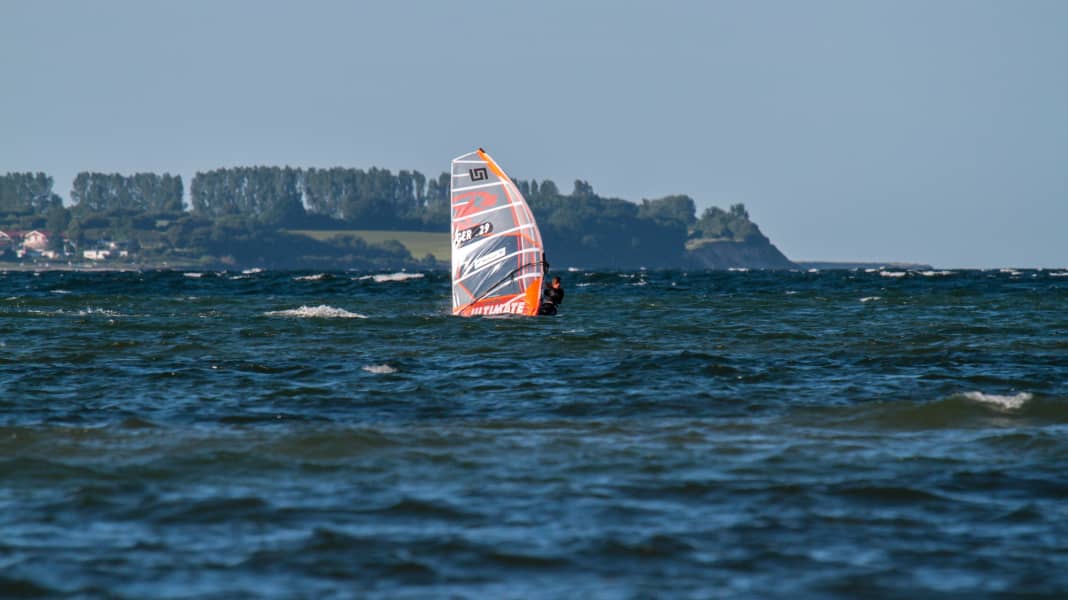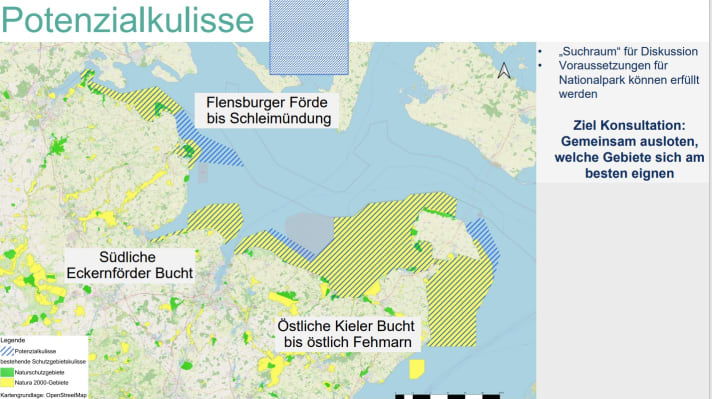Baltic Sea National Park: Schedule for workshops - water sports event on 11 July
Tobias Frauen
· 23.05.2023

There is great uncertainty among water sports enthusiasts in light of the planned Baltic Sea National Park. Many fear for their spots on the coast of Schleswig-Holstein, which was also a key topic at the surf festival on Fehmarn. The lack of understanding as to why recreational athletes, of all people, should have a decisive influence on the state of the Baltic Sea is coupled with the question: What is the current situation and what will happen next?
The ministry roughly outlined the timetable for the process at the kick-off in March: Consultations with various interest groups are to take place in workshops until late summer; these will then be bundled in an "interlocking workshop" in October/November and finalised by the end of the year. According to the ministry's plan, a decision will be made in the second half of 2024.

Water sports in the Baltic Sea National Park are on the agenda on 11 July
The dates for the specialist workshops were announced this week:
- 13.06.2023, Scharbeutz: Agriculture/water management workshop
- 27.06.2023, Lübeck: Tourism workshop
- 30.06.2023, Kiel: Fisheries workshop
- 11.07.2023, Kiel: Water sports workshop
- 30.08.2023, Neumünster: Nature conservation workshop
- 12.09.2023, Scharbeutz: Regional development workshop
- 19.09.2023, Neumünster: Municipalities workshop
"The workshop is intended to bring together as representative a cross-section as possible of the relevant stakeholders with a connection to Schleswig-Holstein's Baltic Sea coast," says the ministry. According to the press release, the following organisations have been invited to the specialist workshop on water sports:
- ASC Kappeln e.V.
- Federal Association of the Water Sports Industry
- CORE Kiteboarding GmbH
- German Wing Foil Association (DWFV e.V.)
- German Motor Yacht Association e.V.
- German Olympic Sports Confederation (DOSB) e.V.
- German Rowing Association e.V.
- German Sailing Association e.V.
- German Surfing Association (DWV)
- DGZRS The Sea Rescuers
- DLRG German Lifesaving Association
- Global Kitesport Association e.V. (GKA)
- Hanseatic City of Lübeck / Tourismus-Agentur Lübecker Bucht AöR
- IHK Schleswig-Holstein
- Kieler Yacht-Club e.V.
- Kitesurf Club Germany e.V.
- Lübeck District Sailing Association
- Kuratorium Sport und Natur e.V.
- State capital Kiel regarding regatta
- Landes-Kanuverband Schleswig-Holstein e.V.
- State Sports Association S.-H. e.V.
- Nordwind Watersports Surendorf
- Point of Sailing Marketing GmbH
- Rowing Association SH
- Sail and Surf Pelzerhaken
- Sailing school Hohwacht / Ostwind Segelsport GmbH
- Sailing school Well Sailing Neustadt
- Sailing Association Schleswig-Holstein e.V.
- Segler-Verband Schleswig-Holstein e.V. Youth Committee
- Lemkenhafen Sailing Club
- Sportjugend Schleswig-Holstein im Landessportverband Schleswig-Holstein e.V. (sjsh)
- Surfer's Paradise Station Laboe
- Surf Club Kiel e.V.
- SUS Hanse Surf
- SH Diving Association
- VDWS International Water Sports Training Association
- Association of German Sports Boat Schools e.V
- Association of German Scuba Divers (VDST)
- Association of German Watersport Schools e.V.
- Watersports Björn Brüggemann, online petition
- Watersports centre Heiligenhafen
- Water Tourism in Schleswig-Holstein e.V.
- Windsurfing Wulfen Fehmarn
Baltic Sea National Park: Surfers from all disciplines unite against spot closures
Windsurfers, wingfoilers, kiters and other water sports enthusiasts began to develop a common, strong position at a strategy meeting in Kiel at the end of April. surf Magazin was also there. The water sports community seems to be divided on the question of whether a national park should be rejected in general or whether it should be supported in the hope that access to the spots will be preserved. The problem: for many water sports enthusiasts, the national park is still a nebulous construct and it is currently impossible to predict which spots would be affected by closures. Accordingly, parts of the water sports community are currently still finding it difficult to reject environmental protection measures and categorically oppose the park.
The opposing side argues that a national park alone would not necessarily improve the condition of the Baltic Sea, as it would not solve the major problems - nutrient input, contaminated sites, ammunition remnants and shipping traffic. In addition - as the example of the Wadden Sea National Park has shown - there is the problem that individual spots within a national park can be closed to water sports enthusiasts by simple administrative acts, e.g. by a municipality, for example if there is a suspicion that sports enthusiasts are disturbing birds or nature. Proving that this is not the case would be almost impossible and would involve lengthy court cases and expensive expert opinions.
The danger: increasingly strict rules over time
Thomas Weinhardt, Honorary Chairman of the VDWS, takes a similar position: "It must be clarified whether a Baltic Sea National Park contributes to better nature conservation and is necessary, or whether it will result in a massive restriction of use for water sports with disproportionate bureaucracy and costs," says Weinhardt.
Experience from comparable other projects has shown that after an initial launch, there will be more and more restrictions over the years, right up to zero utilisation. "Various statements from politicians confirm this danger," fears Weinhardt, who sits at the table for the VDWS.
Numerous protest actions against the Baltic Sea National Park
A massive protest has now formed in the water sports scene: In addition to the large online petition, there is a dedicated website with all the information and the latest reports. The initiators of the meeting in Kiel have also produced an information flyer under the motto "More protection for nature - Yes! Baltic Sea National Park - No!" in order to raise awareness of the issue among as wide a public as possible. This flyer was distributed at the surf festival on Fehmarn, where numerous posters were also on display. Vincent Langer also surfed around Fehmarn to protest against the plans - to name just a few of the actions.
These are the plans for a Baltic Sea National Park

Tobias Goldschmidt has already presented initial plans for a "Baltic Sea National Park" in 2022. It is intended to connect the various nature and bird sanctuaries on the Baltic Sea and at the same time "deepen their protection", as the Green politician says - so that the Baltic Sea "will be better again in the future". This could result in massive restrictions for water sports, as part of a national park are so-called no-use zones in which water sports, shipping and fishing would be taboo. The affected areas can be seen in a "potential map" published at the beginning of the year.
In a national park, at least 50 per cent of the area would have to be left to nature - similar to the Wadden Sea National Park, which is around 300,000 hectares larger than the potential on the Baltic Sea. The ministry hopes that the new national park will provide "a real boost in attractiveness" for the Baltic Sea coast and "enormous opportunities for tourism and the economy", as Goldschmidt told the Schleswig-Holstein newspaper publisher.

